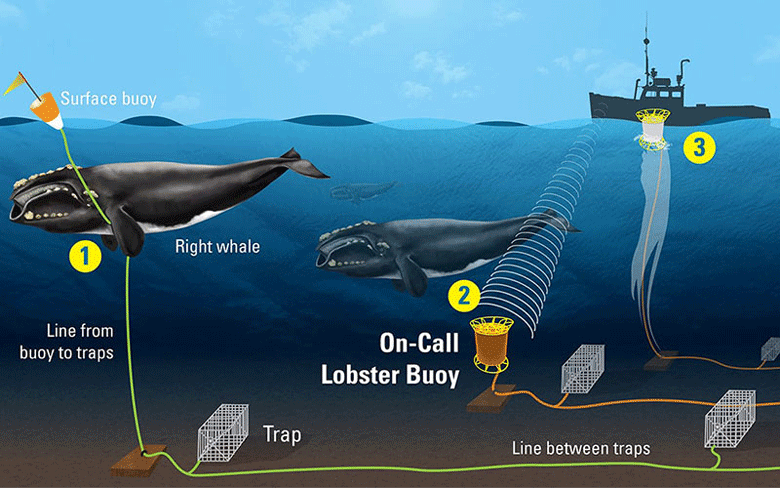This spring, researchers were given an expanded opportunity to test lobster trap gear that eliminates the need for vertical buoy lines in waters traversed by critically endangered North Atlantic right whales.
Under the direction of NOAA and with permission from the Massachusetts Department of Marine Fisheries, a fleet of ten vessels has been allowed since Feb. 1 to use special on-demand lobster traps in either state or federal waters along the eastern coast of Massachusetts and south of Martha’s Vineyard. The fleet has until the end of April to test the traps in areas that are otherwise closed to traditional lobstering to protect the endangered whales from entanglement.
As of late March, lobstermen have retrieved the traps from the ocean floor 186 times, according to NOAA data. The lobstermen and the researchers are continuing to test the effectiveness of both the on-demand gear and the mapping technology used to find the traps.
“DMF’s view is that on-demand technology works best for those that fish long trawls on the larger vessels…”
In this round of permitted fishing, one focus is ensuring the tracking technology is accurate even when traps are in proximity to one another. Semi-retired lobsterman Marc Palombo said this tracking technology recently passed a critical test in federal waters.
“We got another vessel with a satellite with internet on its boat and had it go right next to my boat, and I could see his gear and he could see my gear,” he said.
This effort represents the largest chance yet to experiment with the on-demand traps in real world conditions in New England. For years, researchers have been working to design traps that could eliminate the need for standing vertical lines. Those efforts have met with some resistance, however.
For example, the Massachusetts Department of Marine Fisheries (DMF) denied an application by a group of lobstermen to test experimental gear in 2022. That group did gain an 11th-hour permission from federal regulators to try the gear in lobster harvesting, but only for a few days.
Since then, NOAA’s Northeast Fisheries Science Center received an exempted fishing permit from federal regulators to allow up to 100 fishing vessels to test and improve on-demand gear in a variety of fisheries. Scientists from the center then devised a plan to test the lobster gear in federal waters and approached Massachusetts DMF for permission to fish in state waters just off the coastline. DMF agreed, and both efforts are being directly supervised by NOAA.
In his letter allowing NOAA to set the experimental traps, DMF Director Daniel J. McKiernan did express some skepticism about the practicality of the on-demand traps for coastal lobstering.
“DMF’s view is that on-demand technology works best for those that fish long trawls on the larger vessels in the fleet,” he wrote. “Its applicability and affordability is far less for smaller vessels that fish single traps or short strings of gear in dense gear fields.”
Erica Fuller, a senior attorney for the Conservation Law Foundation, said that even with those doubts, it still made sense for state regulators to greenlight testing near shore, where lobstering activities are at their densest.
“There were some questions about how close can you actually fish this gear to another guy, and those questions weren’t so much being answered in the far offshore,” Fuller said. “While they were trying to get close, those [offshore] trawls are so much longer they’re generally not right on top of one another.”
DMF Director McKiernan is not alone in his skepticism. When asked about the latest round of testing of on demand gear, Beth Casoni, executive director of the The Massachusetts Lobstermen’s Association sent the following statement:
“The Massachusetts Lobstermen’s Association does not support the use of on-demand gear as the economics are not feasible and it will destroy the American lobster fishery.”
For now, Palombo is one of a minority of lobstermen who doesn’t share his colleagues’ pessimism on the evolving technology, and he has been recruiting other Massachusetts fishermen to the effort to test the new traps out. He knows the technology may still be unaffordable at this point for most fishermen, but he says the funding is there to help develop the trap gear, and he’s seen the improvements each year in the experimental gear. People need to remember that it’s a long process to create a new technology, he said.
“I like to use the analogy that we’re the Wright brothers right now,” Palombo said. “They didn’t start out with the F-15 fighter. They were at Kittyhawk, and that’s where we’re at right now. We’re at Kittyhawk.”





